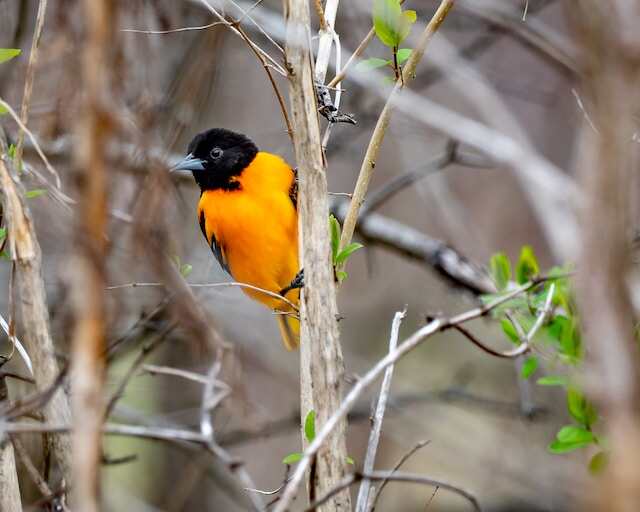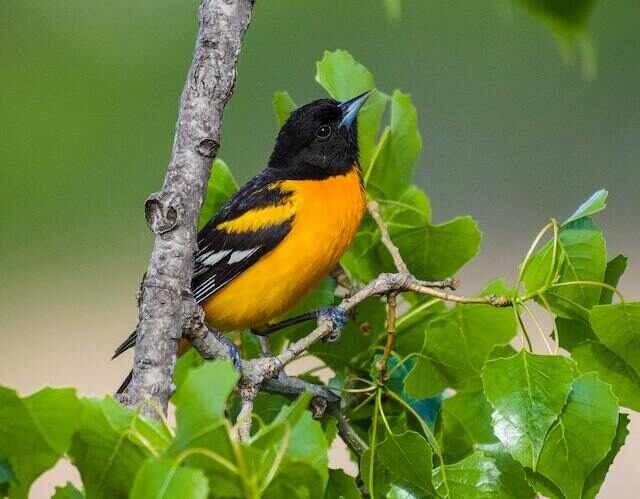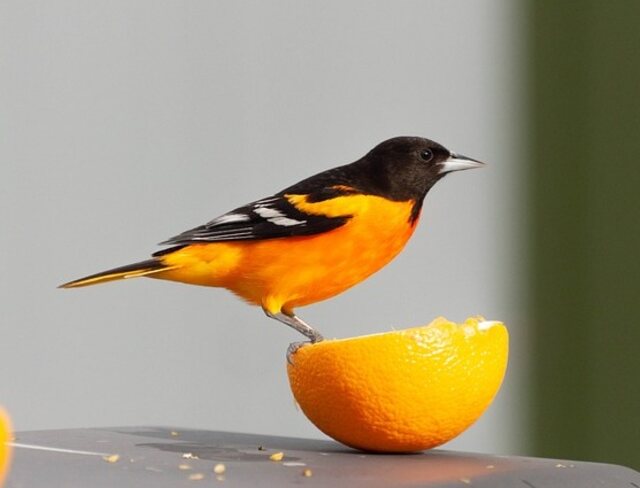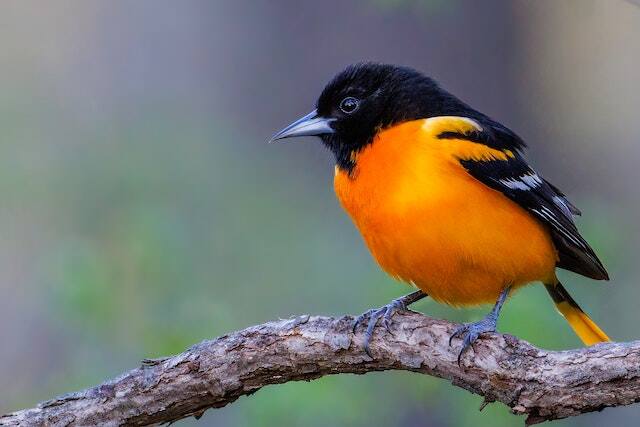Baltimore Orioles are fascinating birds that are known for their distinctive bright orange and black plumage. They are a common sight in the eastern parts of North America, where they inhabit open woodlands, parks, and backyards.
These beautiful birds are highly sought-after by bird enthusiasts and backyard birders alike, and are renowned for their delightful songs and acrobatic flights.
Despite their popularity, there is still much to discover about the feeding habits of Baltimore Orioles. One question that arises frequently is “Do Baltimore Orioles eat oranges?”
While some people believe that oranges are a staple in the Baltimore Orioles’ diet, others are skeptical and wonder if this is just a myth.
In this article, we will seek to answer this question and provide you with a comprehensive overview of Baltimore Orioles’ feeding preferences, common foods they consume, as well as the benefits of feeding them.
So, let’s dive in and explore the world of Baltimore Orioles!
Table of Contents
- 1 Do Baltimore Orioles Eat Oranges?
- 2 Introduction to Baltimore Orioles
- 3 Baltimore Orioles’ Feeding Preferences
- 4 Common Foods Consumed by Baltimore Orioles
- 5 Myth or Reality: Do Baltimore Orioles Eat Oranges?
- 6 Benefits of Feeding Baltimore Orioles
- 7 How to Attract Baltimore Orioles to Your Backyard
- 8 Other Interesting Facts About Baltimore Orioles
- 9 Conclusion and Final Thoughts
- 10 Frequently Asked Questions
- 11 Author
Do Baltimore Orioles Eat Oranges?
Yes, Baltimore Orioles do eat oranges. They are known to have a fondness for fruit, including oranges and other citrus fruits.
Orioles are attracted to the sweet juice and can often be seen pecking into oranges to feed on the pulp.
Offering orange slices or placing orange halves in feeders can be a great way to attract these beautiful birds to your yard.
Introduction to Baltimore Orioles
This section provides an overview of the avian species typically found in Maryland during the warmer months.
One such species is the Baltimore Oriole, which is known for its striking orange and black plumage.
These birds are migratory, breeding in the eastern part of North America and wintering in Central America and northern South America.
Baltimore Orioles are known for their melodious vocalizations and use them for communication during breeding and territorial disputes.
They build their nests in trees, usually at the tips of branches, where they lay their eggs.
While Baltimore Orioles are primarily insectivorous, they also consume fruit, including oranges.
However, their preference for oranges is unknown, and they may choose other fruits over oranges if given the option.
Understanding the Baltimore Oriole’s feeding preferences is important in managing their populations and ensuring their continued survival in their natural habitats.

Baltimore Orioles’ Feeding Preferences
Baltimore Orioles are known for their varied diet that includes nectar, fruits, insects, spiders, seeds, berries and nuts. They have a preference for sugary nectar and juicy fruits like oranges, berries, apples and grapes.
Orioles also feed on insects and spiders, especially during breeding season when they need to provide protein-rich food for their young.
Additionally, they consume seeds and nuts, especially in winter when insects are scarce.
Nectar and Fruit
The consumption behaviors of certain avian species towards specific types of flora provide insight into their dietary preferences and ecological niche.
Baltimore Orioles, known for their bright orange plumage, are nectar drinkers and fruit selectors.
They have long, thin beaks that are perfectly adapted to accessing the nectar within flowers, and they are especially fond of trumpet-shaped blooms.
Orioles also enjoy a variety of fruits, including oranges, berries, and grapes. In fact, they are known to be one of the few bird species that will actively seek out and consume fermented fruit.
Nectar and fruit provide Baltimore Orioles with essential nutrients such as sugars, minerals, and vitamins.
Additionally, as they consume these food sources, they play an important role in pollination and seed dispersal.
By visiting flowers and eating fruit, they help ensure the continued survival and reproduction of the plants that make up their diet.
However, while nectar and fruit make up a significant portion of their diet, they also consume insects and spiders. This diverse diet allows them to thrive in a variety of habitats, from open woodlands to suburban gardens.
Insects and Spiders
In addition to consuming nectar and fruit, Baltimore Orioles also include insects and spiders in their diet, allowing them to thrive in various habitats and play a crucial role in maintaining ecological balance.
As predators, they hunt for insects and spiders, which are their primary source of protein. These foods also provide essential nutrients that help them survive and breed successfully.
Orioles are known to catch insects in mid-air or pluck them from leaves, while spiders are usually caught in webs or on the ground.
Orioles’ consumption of insects and spiders has ecological significance, as it helps control their populations, preventing them from becoming overabundant and causing harm to other species.
Without this natural balance, the ecosystem’s health could suffer.
With their varied diet, Baltimore Orioles are versatile and adaptable birds that can thrive in different environments.
Their ability to consume insects and spiders, in addition to nectar and fruit, makes them a valuable species in maintaining ecological balance.
Moving forward, the discussion will focus on another essential part of their diet, seeds and nuts.
Seeds and Nuts
Seeds and nuts are a crucial element of Baltimore Orioles’ diet, contributing to their health and survival, while also playing a vital role in maintaining the ecological balance of their habitat.
Orioles have a unique way of storing seeds in their gizzards, which allows them to digest them slowly over time, ensuring a steady supply of nutrients.
In addition to providing essential protein and fat, nuts and seeds are also a rich source of vitamins and minerals, including calcium, iron, and vitamin E.
This makes them an ideal food source for birds that need to maintain high energy levels and good health.
It is essential to note that the nutritional value of different seeds and nuts varies, with some being more nutritious than others.
Therefore, Orioles have to be selective in their choice of food, picking only the most nutritionally dense options.
As such, the availability of different seeds and nuts in their habitat plays a vital role in determining their diet.
Common foods consumed by Baltimore Orioles include sunflower seeds, millet, peanuts, and suet, among others.
These foods are readily available in the Orioles’ habitat and are a major part of their diet.

Common Foods Consumed by Baltimore Orioles
Baltimore Orioles are known to consume a variety of fruits, including those with high sugar content, such as berries and grapes, as well as insects and nectar, to meet their nutritional requirements.
Favorite fruits of Baltimore Orioles include blackberries, raspberries, and elderberries.
Research has found that Baltimore Orioles prefer fruits with high sugar concentration, such as blackberries, over those with lower sugar concentration, such as blueberries.
Baltimore orioles’ migration patterns may also influence their food choices, as they may consume more fruits during migration to fuel their long-distance flights.
While Baltimore orioles are primarily known for their love of fruit, they also feed on insects and nectar.
However, do Baltimore orioles eat oranges? This is a question that has sparked debates and myth-making.
Myth or Reality: Do Baltimore Orioles Eat Oranges?
The question of whether Baltimore Orioles eat oranges is a common one among bird enthusiasts.
Some may argue that it is a myth, while others believe it to be a reality.
To delve deeper into this topic, it is essential to consider scientific evidence and expert opinions.
By examining these factors, we can gain a better understanding of the dietary habits of Baltimore Orioles and whether or not oranges play a role in their diet.
Scientific Evidence
Research on the dietary habits of certain bird species has revealed interesting findings regarding their consumption of certain fruits, which may surprise those who assume that birds primarily subsist on insects or seeds.
When it comes to Baltimore Orioles, the answer to the question of whether or not they eat oranges is a resounding yes.
In fact, these birds have a particular affinity for citrus fruits, such as oranges and grapefruits.
However, it is important to note that not all species of birds can tolerate citrus fruits due to their acidity, which can cause digestive issues or even citrus allergies.
Nevertheless, Baltimore Orioles have developed a keen ability to digest these fruits, which are rich in sugar and provide them with the necessary energy to fuel their migration.
These findings are supported by scientific evidence, which has confirmed that the consumption of oranges is indeed part of the Baltimore Oriole’s diet.
This information may come as a surprise to those who had previously assumed that birds only consume insects or seeds.
As we move forward, it is important to consider the expert opinions of ornithologists and bird enthusiasts who can provide further insight into the dietary habits and preferences of these fascinating creatures.
Expert Opinions
Expert opinions provide valuable insight into the dietary habits of certain bird species, including the Baltimore oriole.
Ornithologist insights suggest that these birds have a varied diet and consume a wide range of fruits, insects, and nectar.
While oranges may not be a staple in their diet, they have been observed to consume them on occasion, particularly when other food sources are scarce.
Additionally, feeding Baltimore Orioles oranges can provide them with a source of essential vitamins and nutrients, such as vitamin C and potassium.
However, it is important to note that their diet should not solely consist of oranges, and a balanced and varied diet is necessary for optimal health.
With this understanding, feeding Baltimore Orioles oranges can be a beneficial supplement to their diet.

Benefits of Feeding Baltimore Orioles
Feeding these beautiful birds with nutrient-rich foods can improve their overall health, and ultimately, contribute to the conservation of their species.
Providing Baltimore Orioles with a steady source of food can help maintain their energy levels, especially during migration periods.
This can increase their chances of survival, as they need to continue flying long distances to reach breeding grounds.
Additionally, attracting these birds to your backyard can be an enjoyable experience for bird enthusiasts, providing an opportunity to observe their vibrant feathers and melodious songs up close.
By using attractants such as oranges, jelly, and nectar feeders, you can create a welcoming environment for these birds.
Overall, feeding Baltimore Orioles not only benefits their health, but also provides a chance for people to connect with nature in their own backyard.
Transitioning into the subsequent section, learning how to attract Baltimore Orioles to your backyard can further enhance this experience.
How to Attract Baltimore Orioles to Your Backyard
Creating a welcoming environment for Baltimore Orioles in your backyard involves backyard landscaping and utilizing attractants such as jelly and nectar feeders, strategically placed foliage for nesting, and offering fresh water sources.
Backyard landscaping involves creating a natural habitat for these birds by planting native trees, shrubs, and flowers. Adding a bird bath or a shallow dish filled with water can also help attract Baltimore Orioles.
Jelly and nectar feeders are a great way to provide these birds with food, and they prefer grape jelly, orange marmalade, and nectar. It’s essential to place the feeders in a location where the birds can see and access them easily.
Additionally, strategically placing foliage for nesting can be a great way to attract Baltimore Orioles to your backyard. These birds prefer to nest in trees with dense foliage that provides cover from predators.
Incorporating these birdwatching tips into your backyard landscaping can create a welcoming environment that attracts Baltimore Orioles.
Other interesting facts about Baltimore Orioles include their bright orange plumage, their unique song, and their preference for insects and fruit in their diet.
Other Interesting Facts About Baltimore Orioles
Further insights about these birds include their migratory patterns, with some populations traveling from as far as South America to breed in North America during the summer months.
The Baltimore Orioles are known to migrate long distances, and their journey may take up to two months.
They are also known for their vibrant orange plumage, which makes them a sight to behold.
However, despite their beauty, they are currently listed as a species of least concern on the IUCN Red List, meaning that they are not currently facing any major threats to their survival.
Other interesting facts about Baltimore Orioles include their preference for nesting in tall trees and their diet, which consists mainly of insects, spiders, and fruit.
In fact, while they are not known to eat oranges, they have been observed feeding on various types of fruit, including berries and grapes.
Overall, the Baltimore Orioles are fascinating creatures that have captured the attention of many bird enthusiasts, and their migration patterns and conservation status are important topics for further research and study.
Moving towards the conclusion and final thoughts, it is clear that these birds play an important role in the ecosystem, and efforts should be made to protect their habitats and ensure their survival for generations to come.

Conclusion and Final Thoughts
In conclusion, the migratory patterns and conservation status of the Baltimore Oriole are significant topics that warrant further research and attention to ensure the preservation of these captivating birds for future generations.
As we have learned, Baltimore Orioles are not known to eat oranges, despite their name. However, they do have a varied diet that includes insects, nectar, fruit, and sometimes even the eggs and young of other birds.
It is important to remember that feeding birds can have a positive impact on their survival, but it is crucial to provide them with appropriate food and to avoid feeding them foods that could be harmful.
Additionally, there are many different bird species that can benefit from feeding, and it is important to research the specific needs of each species to ensure that they receive adequate nutrition.
By taking these steps, we can help to support the bird populations in our communities and ensure that they thrive for generations to come.
| Importance of feeding birds | Different bird species |
|---|---|
| Helps support bird populations | Blue Jays |
| Provides needed nutrition | Chickadees |
| Can have a positive impact on survival | Cardinals |
Frequently Asked Questions
What is the average lifespan of a Baltimore Oriole?
The average lifespan of a Baltimore oriole is approximately 5-6 years, although some individuals may live up to 10 years. Factors affecting the lifespan of these birds include their diet and habitat.
Baltimore Orioles are primarily insectivores, feeding on a variety of insects such as caterpillars, beetles, and grasshoppers.
They also consume fruits and nectar. The availability of food sources and the quality of their habitat play a crucial role in their survival and overall health.
Research suggests that human activities, such as habitat destruction and climate change, may negatively impact the lifespan of Baltimore Orioles.
It is important to continue studying these birds and their habitat to better understand their needs and promote conservation efforts.
How do Baltimore Orioles mate and reproduce?
Baltimore orioles are known for their beautiful plumage and melodic songs. However, their mating and reproductive habits are just as fascinating.
These birds typically breed between May and June, with males engaging in courtship behaviors such as puffing out their feathers, singing loudly, and performing aerial displays to attract females.
Once a pair has formed, they work together to build a well-camouflaged nest in a tree or shrub.
Baltimore Orioles have a unique nesting habit of weaving plant fibers, grass, and hair to create a hanging basket-shaped nest. The female lays 3-7 eggs, which incubate for approximately 12–14 days.
Both parents take turns feeding and caring for the nestlings until they fledge at around 14–16 days old.
Overall, the mating and reproductive behaviors of Baltimore orioles are intricate and highlight the importance of courtship and cooperation in successful avian breeding.
What is the migration pattern of Baltimore Orioles?
Baltimore Orioles are migratory birds that breed in North America during the summer months and winter in Central and South America.
Their migration patterns are influenced by environmental cues such as temperature, food availability, and photoperiod.
These birds are known to travel long distances, covering up to 4,000 miles during their annual migration.
Habitat preference is an important factor in their migration patterns as well, with Baltimore Orioles favoring wooded areas and open forests.
The birds are also known to use the Gulf of Mexico as a major migration route.
The timing of their migration varies depending on location, with birds in the western United States migrating earlier than those in the eastern United States.
Understanding the migration patterns and habitat preferences of Baltimore Orioles is crucial for conservation efforts and can provide insights into the ecological health of their breeding and wintering grounds.
How do Baltimore Orioles communicate with each other?
Baltimore orioles are known for their intricate communication skills, which are crucial for their survival. Their vocalizations and body language play a significant role in conveying messages to their peers.
Orioles make use of a variety of calls and songs to interact with each other, indicating different messages such as warnings of predators, territorial boundaries, and mating calls.
They also use their body language to communicate, such as fluffing their feathers to appear larger or tilting their head to signal aggression.
Research has shown that orioles have a complex system of communication, enabling them to convey nuanced information to their peers.
Their ability to communicate effectively is essential for their survival, and it serves as a testament to their adaptability and intelligence.
What are some predators of Baltimore Orioles?
Baltimore Orioles are small, colorful birds that inhabit the eastern parts of North America. They are found in a variety of habitats, including forests, woodlands, and suburban areas.
While they are known for their beautiful songs and striking plumage, they are also prey to a wide range of predators.
Birds of prey such as hawks, falcons, and owls are the most common predators of Baltimore Orioles. These birds rely on their sharp talons and beaks to capture and kill their prey.
Additionally, some mammals such as cats and snakes may also target Baltimore Orioles.
However, despite the threat of predation, Baltimore Orioles are able to thrive in their natural habitat and continue to be appreciated by bird enthusiasts for their beauty and unique behavior.


